Bag-shelter Moth, Processionary Caterpillar - Ochrogaster lunifer
Family NOTODONTIDAE
This page contains pictures and information about Processionary Caterpillars and Bag-shelter Moths that we found in the Brisbane area, Queensland, Australia.

- Male, body length 25mm
- For this species the adult moth is known as Bag-shelter Moth and the caterpillar is known as Processionary Caterpillar. They are common in Brisbane bushes. Caterpillars in large number can be found resting/hiding on base of medium to large size wattle tree trunks in most area in Brisbane. In 2008 all year round, we found that in the bushland in Wishart near Bulimba Creek, almost every medium and large wattle trees were infested by the caterpillars. Look up at those wattle trees, half of their leaves were missing.
- Caterpillars and moths are known will cause irritation for human and other animals. Female moths lay eggs mass covered by hairs and scales. The airborne caterpillar hairs and moth scales will cause rashes and also respiratory problems such as asthma.
The Moth



- Quite a number of these moths flying actively during the day in Karawatha Forest on Oct. Male moth has the white hairs on the tip of the abdomen. Otherwise, male and female look about the same. The moth is dark brown in colour, with a white dot on each forewing. The head and legs are covered with long brown hairs. The abdomen is banded and covered with brown hairs.
The Caterpillars
-
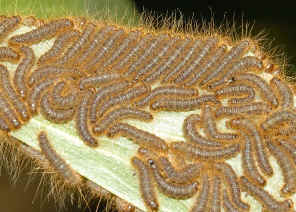


- Small caterpillar feeding Small caterpillar length 5mm Large caterpillars length 50mm, hiding in bag-shelter
- The caterpillars are dark brown in colour with brown head. The body is covered with long soft hairs. The eggs and small caterpillars are protected by the substance produced by the mother moth. Later the nest is protected by the silk produced by the larger caterpillar.


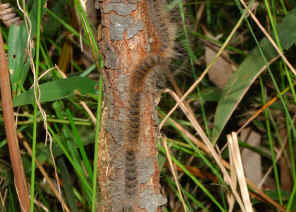
- Curls into a ball when disturbed Large caterpillars feeding In processions
- They are famous for walking in processions. They walk up, one follow another one, along the wattle tree trunk and feed on the leaves. If they consume the whole tree, they will move to another tree, also walking in processions.


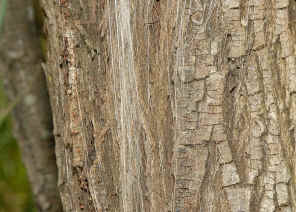
- Going up to tree top for feeding The 'Silk Road'



- Each caterpillar when walks, leaves a trail of silk on its way. The another caterpillar follows this silk trail nose to tail and form the processions. Multiples silk trails can be found on the infested tree trunk.
-
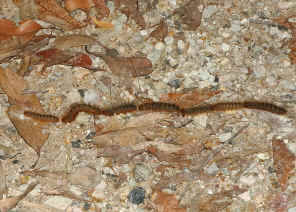


- Crossing footpath, looking for new host tree
The Development Cycle
- Processionary Caterpillars develop in an annually cycle. Following are the records in Brisbane bushlands.
Early summer, 15 Nov - Female lay eggs mass



- Eggs mass, diameter 30mm Small Caterpillar just hatched
- Female moths lay eggs in a single mass on base of wattle tree trunks. The moths produce a layer of substance covering the eggs as protection. Each moth lays a single batch of 150-500eggs. Usually there are more than one female lay eggs on the same tree trunk. The eggs hatch into small caterpillars but they remain stay in the egg mass until the first moult.
-



Mid-summer, 15 Dec - young caterpillars feed on leaves during the day



- Young caterpillars feeding on wattle leaves, length 5mm
- These shed their skins and emerge as second stage caterpillars. They feed on leaves during the day. They travel up follow each other to the tree top where they feed in group on the wattle leaves.
-

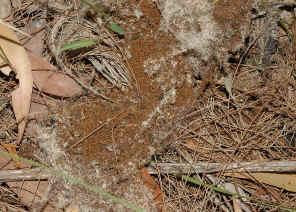
- The second and third stage caterpillars feed during the day. At the end of the day, they return to their nest at the base of the tree.
Late-summer, 15 Jan - caterpillars developing
Late-summer, 15 Feb - made silk bag shelter



- Silken bag shelter Trail of silks - the 'Silk Road'
- Each caterpillar when walks, leaves a trail of silk on its way. The another caterpillar follows this silk trail nose to tail and form the processions. Multiples silk trails can be found on the tree trunk. After days those silk lines near tree trunk form a silk bag as their nest. During the day the caterpillars hide together in their nest. They left their droppings and moulted skins inside the nest. They form procession line, one follow each other, climb up to the tree and feed on leaves during the night.
Late-summer, 15 Mar - hide in bag shelter during the day



- Large silken bag shelter Large caterpillars, 40mm
- When the caterpillar became larger, the nest is protected by the thicken silks that they produced, i.e., the Silken Bag Shelter. They climb up the tree and feed at night. If they consume the whole tree, they will move to another tree, also walking in processions. Inside the nest the caterpillars rest on the top of their droppings, their moulted skins and their hairs. There could be 300 or more caterpillars in one nest.



- Large caterpillars, grow up to 50mm
- Usually up at this time, they may have consume the whole tree, they will move to another tree, walk in processions. While finding other trees, they may sperate into smaller groups.



- In processions
- On mid Apr, we saw some groups feeding in the morning. About photos we taken just after their feeding and walked down tree, in processions, back to the nest at tree base. It was about 10:00am in the morning.



- Larger caterpillars grouped in smaller number



- On end Apr morning while we were in Karawatha Forest, we meet this small group of Processionary Caterpillars. There were seven of them crossing the footpath. They were about 40-50mm in length. The first caterpillar walked a little bit faster and its head was flipping left and right searching the way. When it was 3-4mm apart from the second, it stopped and waited for it. When the second caterpillar came up and touch its tails, it then kept the slight walk faster and searching movement. The six caterpillars just followed it at a constant speed. We did not noticed anything attached between them, no silks or any other attachment. The just form a line by everybody touching nose and tail. If the one behind could not follow, the front one just stopped and waited, until all touching each others. After they cross the footpath, they moved into the area that covered with plants materials and dense vegetations that we could not followed.
- At this time of the season, we found that in each nest we examined, they were all small group of less then a hundred caterpillars, some are even less than ten. There were many empty nests with the host tree no leaves at all. Some host trees started to re-grow its leaves. We also found some empty nests that the host tree still had many old leaves. Assumed that those caterpillars will consume the whole tree before they left. We believed those caterpillars many already had fed enough and went for pupation.
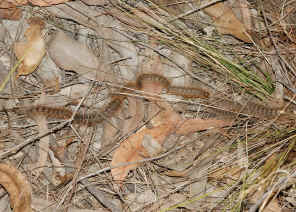


- On end Apr, we saw another medium size group, about fifty caterpillars travelled from somewhere and settled down at the base of a She-oak tree. We then found quite a number of nests were at the base of She-oak trees (Casuarina sp.). There were silks on the bare stems and evident that they fed on those trees. This was not common at the early of the season. Some of the caterpillars might have switched host plants from Wattle to She-oak due to lag of supply.
- The caterpillars fully grown in May. The caterpillars leave the nest, move in procession to find suitable place for pupation. The caterpillars make silk cocoon chamber in soil under plant materials.
- On early May, we found most silken bag shelter were empty, although a few still have caterpillar hiding inside.
Early Autumn, 15 Apr - in processions, separate into smaller groups
End Apr - in processions, separate into smaller groups
End Autumn, May - prepare for winter
Winter, June to September
- They stay as caterpillars in the cocoon chamber through the winter, form June to September. They have no activities can be seen during this time of the year. The host plant, wattle, flowering during the winter.
Sep to Oct - pupate
- The caterpillars turn into pupas in spring, September to October. Each caterpillar goes through eight moults before they pupate.

- Processionary Caterpillars turned into pupae
Spring, 15 Oct - adult moths flying everywhere during the day
- Some references advised the moths are active from late afternoon and early evening, but we found many them flying during the day.



- Adult moths, Oct 2008
- Moths appear in large number within a short period. The adult moths does not feed and have no mouth parts. They live only a few days. They find their mates, lay eggs and die after finish their duty. The cycle ends and the cycle starts again.
-
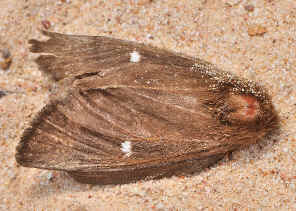

- Found lying on forest ground on Oct 2010
- The Processionary Caterpillars are known will feed on different native trees, mainly on different species of Wattles. In Brisbane we usually found them on Black Wattle (Acacia leiocalyx and Acacia concurrens).



- The host plant, Black Wattle, flowering during winter season. The Processionary Caterpillars have no activities during this time of the year. They stay in the cocoon chamber through the winter.


- For the infested host plant, usually all the leaves at bottom half of the tree are missing. The caterpillars eat all the leaves, including old and new, leaving only the bare stems. Silk trails can be found on those stems and tree trunk. If they consume the whole tree, they will move to another tree, walk in processions.
- Usually, from our observation, those wattle trees will recover slowly after the caterpillars have gone. The host tree may not lose too much due to the caterpillars. The wastes and shed skins of those caterpillar are all left on the base of the tree trunk. They should be the very good fertilizer.
- The moths and caterpillars are protected by their dense long itch hairy and scale. The caterpillars are further protected by their silk bag shelter and habits. They do not have many predators. However, scientists do found that they are subjected to parasite by Tachinid Fly. Scientists found the pupa cases of Tachinid Fly inside their bag-shelter. From reference information, Processionary Caterpillars is parasite by the Tachinid Fly Carcelimyia dispar (Diptera: Tachinidae: Goniinae).



- We took the above photos when observing the Processionary Caterpillars. There was a Tachinid Fly (? sp.) very interested and watching the small caterpillars. It is believed that Tachinid Fly lays eggs on leaves and those eggs enters the caterpillars body while they are feeding.

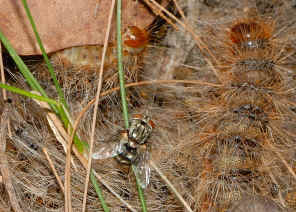

- When observing the bag-shelter, we also saw some Flash Flies flying around, also interesting in the caterpillars nest.
-


- Processionary Caterpillars is parasite by the Tachinid Fly Carcelimyia dispar (Diptera: Tachinidae: Goniinae). We have detail observations and recorded in the Processionary Caterpillar Parasitic Fly page.
- Reference:
- 1. Ochrogaster lunifer (Herrich-Schaffer, [1855]) - Don Herbison-Evans & Stella Crossley, Australian Caterpillars, 2011.
- 2. Bag-shelter Moths and processionary caterpillars Fact Sheet - Queensland Museum 2006.
- 3. Biology of Ochrogaster lunifer Herrich-Schaeffer (Lepidoptera: Thaumetoedae), a defoliator of Acacia acuminata Bentham, in the Western Australian wheatbelt - J.J. Van Schagen, J.D. Majer, and R.J. Hobbs, Australian Entomological Magazine, Volume 19, Number 1 (1992), pp. 19-24.
- 4. Life tables of the processionary caterpillar Ochrogaster lunifer Herrich-Schäffer (Lepidoptera: Thaumetopoeidae) at local and regional scales - Graham J. Floater & Myron P. Zalucki,, Australian Journal of Entomology, Volume 38, Number 4 (1999), pp. 330-339.
- 5. A Guide to Australian Moths - Paul Zborowski, Ted Edwards, CSIRO PUBLISHING, 2007, p175.
